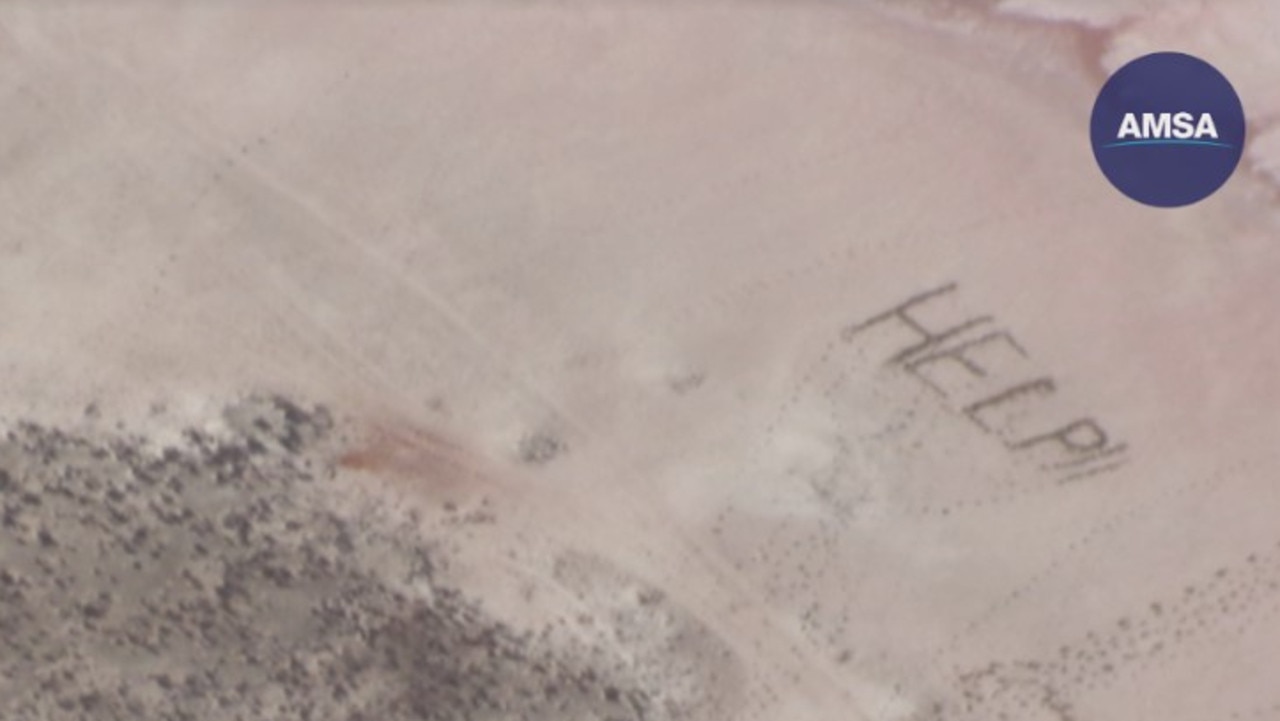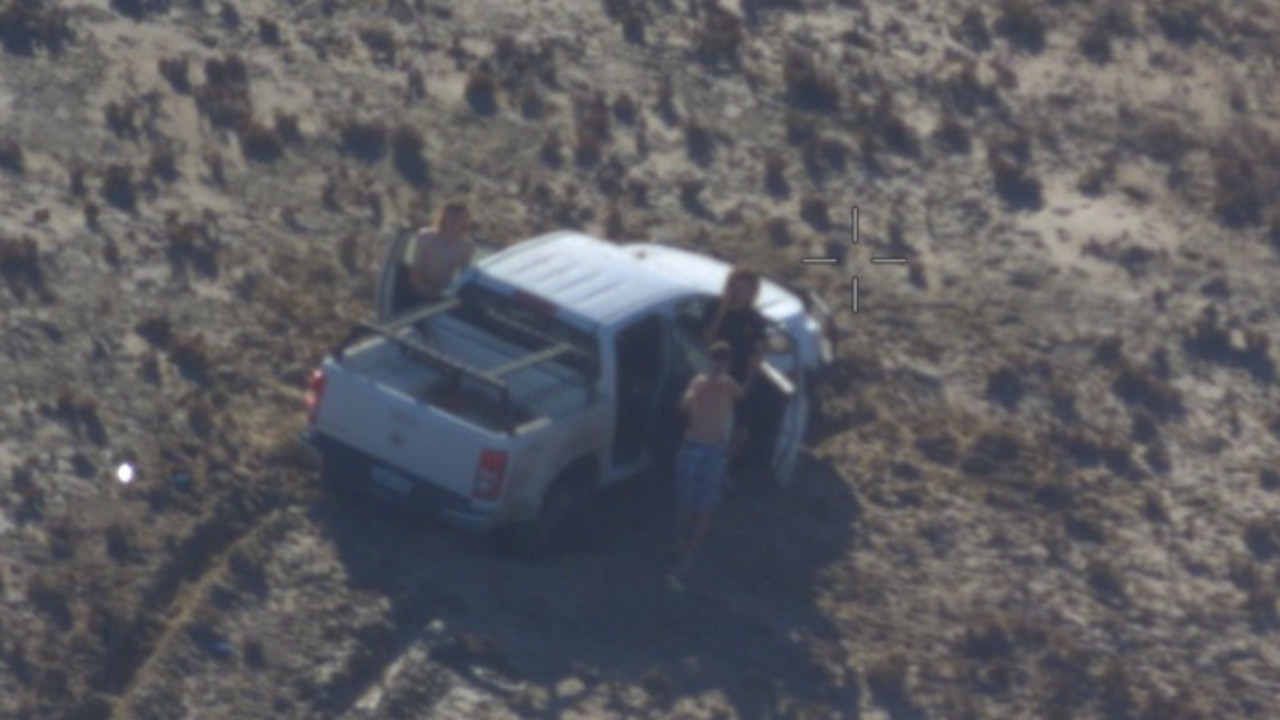Three teenagers saved in remote WA as HELP sign spotted in sand
Stranded in a remote area of Western Australia, three teenagers were rescued and brought to safety after their plea for help written in the sand was spotted by two passing pilots

READING LEVEL: GREEN
Three teenagers have been rescued following a lengthy operation sparked by a HELP message written in the sand in a remote area of Western Australia.
The group’s white Holden Colorado became bogged in the Pink Lake area in Gregory, south of Kalbarri, however they managed to scrawl a large “HELP!!” message in the sand, which was seen by pilots from the air.

Police later noted they did not have any 4WD recover equipment or an emergency beacon.
At about 3pm on Saturday Air Traffic Control notified WA Police that a pilot had spotted the cry for help about 27 nautical* miles south of Kalbarri, with a stuck vehicle seen nearby, which was shortly followed by another report lodged by a second pilot.
A joint operation between officers from Kalbarri Police and Mid West–Gascoyne Traffic area, and a Challenger jet deployed by the Australian Maritime Safety Authority (AMSA), established the GPS* coordinates of the bogged 4WD, allowing police to reach the vehicle.

Officers resorted* to reaching the group by foot, traversing* scrub and the dry lake.
By the time police reached the group, the teenagers, while uninjured, had been stranded for about six hours.
Bystanders had also approached the scene, however they were unable to recover the vehicle due to the harsh terrain*.
WA Police said the vehicle would be recovered at a later time, however the three teens were driven to Lucky Bay, about 72km east, and reunited with their family and friends.
POLL
GLOSSARY
- nautical: relating to ships, sailing and navigation
- GPS: Global Positioning System, a satellite-based radio navigation system
- resorted: having to change a course of action to overcome ore resolve a difficult situation
- traversing: passing through, moving or travelling through an area
- terrain: an area of land or a type of land when taking into account its physical features
EXTRA READING
Castaways saved by sign on sand
Tunnel workers saved by rat-hole rescue
Solo rower’s incredible survival and homecoming adventure
QUICK QUIZ
- Where did the group become bogged?
- The police noted that which two important items were missing from their equipment?
- Who was involved in the join rescue operation?
- How long were the teenagers stranded?
- How did officers reach the group?
LISTEN TO THIS STORY
CLASSROOM ACTIVITIES
1. Stranded on a deserted beach
Crafting the word “HELP” in the sand was an act of ingenuity. Other stranded adventurers have been saved by writing “SOS” in the sand in the past.
If you were stranded on a deserted beach, and were hoping that someone had been alerted and was searching for you, come up with three other ways of alerting search and rescue teams of your whereabouts. Think about possible materials you may be able to use and how to display them.
1.
2.
3.
Time: allow 15 minutes to complete this activity
Curriculum Links: English, Design and Technologies, Personal and Social, Critical and Creative Thinking
2. Extension
If you were planning a trip that could go wrong, what are five things you would take in a survival pack to use if you get stranded in the bus or on a deserted beach or at sea?
1.
2.
3.
4.
5.
Time: allow 10 minutes to complete this activity
Curriculum Links: English, Personal and Social, Critical and Creative Thinking
VCOP ACTIVITY
Game: beach rescue adventure
Objective:
– To explore language features such as descriptive language, vocabulary and sequencing in the article.
– Suitable for children aged 7-10
Instructions:
1. Set the Scene (two minutes):
– Explain to the children that they are going on a remote rescue adventure, just like the one described in the article.
– Describe the scenario: Three stranded teenagers have been rescued from a remote beach in WA after crafting a giant “HELP” message in the sand. The story is about the rescue and the teamwork involved.
– Discuss the importance of teamwork, resilience, and ingenuity in the remote rescue mission, drawing parallels to real-life situations.
2. Language feature hunt (five minutes):
– Read aloud a paragraph from the article, focusing on a specific language feature such as descriptive language, vocabulary or sequencing.
– Add keywords to the board or an anchor chart for referencing.
– After reading, ask the children to identify examples of the targeted language feature from the paragraph.
For example, if focusing on descriptive language, ask the children to identify words or phrases that paint a picture in their minds about the island or the rescue mission.
3. Rescue mission storytelling (10 minutes):
Example story for modelling – the story has been broken into smaller chunks to allow adaptation for groups that struggle with the cognitive demands of storytelling
Title: The Great Remote Rescue
Beginning: Once upon a time, three brave teenagers set out on a 4WD trip to a remote Australian beach. They drove across rough terrain, feeling the warm sun on their faces and the salty breeze in their hair.
Middle: However, disaster struck when their vehicle became bogged, and they found themselves stranded. Determined to survive, they used the sand to carve a giant “HELP” sign, hoping to catch the attention of passing planes.
End: Finally, after six hours of waiting, a rescue crew arrived on foot. With tears of joy, they were rescued and taken back home, safe and sound.
– Divide the children into small groups of three or four.
– Provide each group with a large piece of paper and markers.
– Explain that each group will create a story about a rescue mission to save stranded people on a deserted island, like the one in the article.
– Encourage the children to use descriptive language, vocabulary, and sequencing to tell their story.
– Each group member takes turns adding a sentence or two to the story, building on what the previous person said.
– Encourage creativity and imagination as they create their island rescue adventure.
Adaptation: Stories can be verbal and use lapboards or comic strip templates to help students plan their ideas.
4. Share and reflect (three minutes):
– After 10 minutes, invite each group to share their island rescue story with the class.
– Encourage the children to listen carefully to each story and identify the language features used, such as descriptive language or sequencing.
– Reflect on the storytelling process, discussing what they enjoyed about creating their rescue mission stories and what language features they found most effective.
Adaptation: To reduce time, have one group share to the class for modelling, then groups pair up to present to each other.
Extension (optional):
– Encourage the children to draw illustrations to accompany their island rescue stories, depicting scenes from their adventurous tales.

